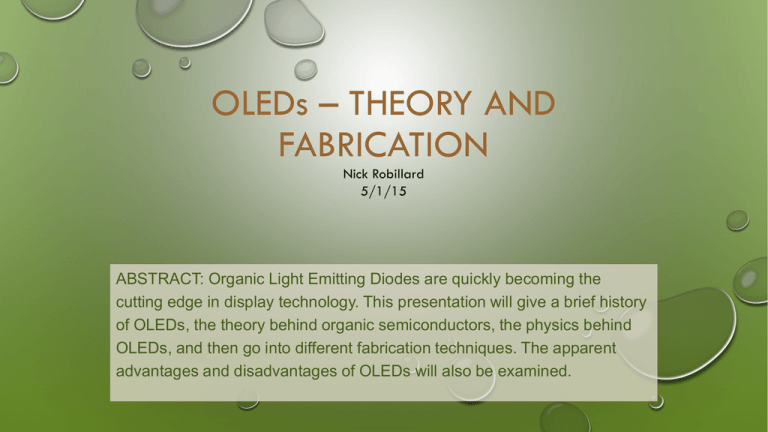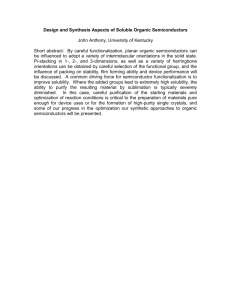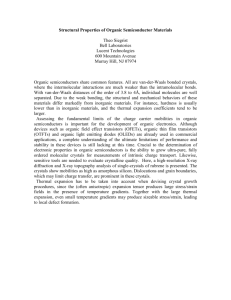OLEDs * Theory and Fabrication
advertisement

OLEDs – THEORY AND FABRICATION Nick Robillard 5/1/15 ABSTRACT: Organic Light Emitting Diodes are quickly becoming the cutting edge in display technology. This presentation will give a brief history of OLEDs, the theory behind organic semiconductors, the physics behind OLEDs, and then go into different fabrication techniques. The apparent advantages and disadvantages of OLEDs will also be examined. OUTLINE History Organic Semiconductors Physics of OLEDs Fabrication Advantages/Disadvantages HISTORY OF OLEDs • 1862 – Henry Letheby • • 1950s – Andre Bernanose • • • • 1st partly conductive polymer: polyaniline 1st observation of organic electroluminesce 1960 – Martin Pope • Developed ohmic dark-injecting electrode contacts for organic crystals • basis for charge injection in all modern OLED devices 1977 – Hideki Shirakawa • high conductivity in iodine-doped polyacetylene • Awarded Nobel Prize in Chemistry 1987 – Ching Tang & Steven Van Slyke • first organic diode device for Eastman Kodak http://www.npg.org.uk/collections/search/portraitLarge/mw124586/HenryLetheby?LinkID=mp87183&search=sas&sText=Letheby&OConly=true&role=sit&rNo=0 History of OLEDs(cont) • • 1990 – JH Burroughs • High efficiency green light emitting polymers • Sheets 100 nm thick 1998 – Kodak & Sanyo • • 2007 – Sony • • First OLED TV in Japan 2010 – Samsung • • Full-Color AMOLED 7 inch Super-AMOLED display 2012 – LG • 55 in TV display Organic Semiconductors • Carbon polymers • Plastic • Insulator? • Doping • Heeger, MacDiarmid, and Shirakawa • Oxidize a thin film of polyacetylene with iodine vapor • Increase conductivity a billion times • Much like doping of conventional semiconductors ORGANIC SEMICONDUCTORS(cont.) • Conductive Polymer 1. Conjugate double bonds Polyacetylene 2. Doping • Oxidation (P-doping) • Halogen gas • Ex.) [CH]n + 3x/2 I2 --> [CH]nx+ + x I3- • Reduction(n-doping) • Alkali metal • Ex.) [CH]n + x Na --> [CH]nx- + x Na+ http://www.nobelprize.org/nobel_prizes/chemistry/laureates/2000/popular.html π and σ Bonds Organic Semiconductors(cont.) • Most organic materials are intrinsically p-type • Higher hole mobility than electron mobility • Opposite of non-organic semiconductors • Trap states • Electrons more susceptible to trapping • Impurities frequently have empty orbitals (that trap electrons) below -3eV • Filled orbitals (which trap holes) above -5eV are not as common http://www.nature.com/nmat/journal/v11/n10/full/nmat3427.html?WT.ec_id=NMAT-201210 Physics of OLEDs • Cathode • Emissive layer • “N-type” polymer • Ex.) polyfluorene • Conducting layer • “P-type” polymer • Ex.) polyaniline • Anode http://electronics.howstuffworks.com/oled1.htm Physics of OLEDs(cont.) • Electrophosphorescence • Voltage applied across device • Electron-hole recombination • Energy released in the form of light • ∆ E = E(LUMO) – E (HOMO) = h ν = h c / λ • Different emissive polymers emit different wavelengths of light • http://ieeexplore.ieee.org/ielx5/6329165/6338451/6338465/html/i mg/6338465-fig-2-small.gif Displays will use several types of organic lights to make the different colors http://www.nobelprize.org/nobel_prizes/chemistry/laureates/2000/advancedchemistryprize2000.pdf Physics of OLEDs(cont.) • Operating voltage: 2-10V • Very dynamic • Can emit all steps between 0% and 100% light, depending on the current • V-I Characteristic • Hysteresis for different sweep directions • Transient behavior likely from deep traps http://ieeexplore.ieee.org/stamp/stamp.jsp?arnumber=1503740 Fabrication of OLEDs • General layout • Three Types: 1. Vacuum Deposition/Vacuum Thermal Evaporation(VTE) 2. Organic Vapor Phase Deposition 3. Inkjet Printing http://ieeexplore.ieee.org/xpls/icp.jsp?arnumber=6338465 Vacuum Thermal Evaporation • Very low pressure (10-6 or 10-5 Torr) • Organic molecules heated until evaporation • Condense on a cooled substrate • Thickness of each layer can be precisely controlled • Disadvantages: 1. Evaporant condensed on cold walls can flake off, contaminating the system and substrate 2. Controlling uniformity and doping concentration over large areas are very difficult 3. Very expensive and inefficient Organic Vapor Phase Deposition • Process: • Organic compound is thermally evaporated • Fed into a diluting, non-reactive gas stream(such as nitrogen) • Condenses onto a cooled substrate • Improves control over doping • Controlled by both temperature and carrier gas flow rate • Better for large-area substrates http://www.princeton.edu/~benziger/OVPD.pdf Inkjet Printing • Process: • Organic materials diluted into a liquid and sprayed onto substrates, just like a standard inkjet printer • State-of-the-art • Current Research Area • MIT spinout Kateeva • Many techniques are proprietary • Organic Vapor Jet Printing • Developed at Princeton • Uses vaporized organics instead of the liquid based jets of other inkjet printers • Drastically decreases manufacturing costs and paves the way for flexible and large-screen models http://www.princeton.edu/~benziger/OVPD.pdf ADVANTAGES • Relatively easy and cheap to produce • Drastically reduce power consumption of displays • Flexible, foldable, and transparent displays DISADVANTAGES • Questionable lifespan • Blue OLEDs currently degrade significantly faster than red and green • Color balance •http://www.oled-info.com/files/4DS-transparent-PMOLED-img_assist-351x263.jpg Water damage susceptibility • Expensive manufacturing http://i.ytimg.com/vi/mLMWXBv5rY4/hqdefault.jpg Summary • OLEDs are made of organic semiconductors • Discovered by accident by Hideki Shirakawa • Conjugated Bonds and Doping • Physics of Electrophosphorescence • Fabrication • Vacuum Thermal Deposition • Organic Vapor Phase Deposition • Inkjet Printing • Advantages/Disadvantages References • http://newsoffice.mit.edu/2015/mass-produced-inkjet-printed-oled-displays-0212 • http://www.princeton.edu/~benziger/OVPD.pdf • http://ieeexplore.ieee.org.libpdb.d.umn.edu:2048/stamp/stamp.jsp?tp=&arnumber=1511521 • http://electronics.howstuffworks.com/oled7.htm • http://spectrum.ieee.org/tech-talk/semiconductors/materials/organic-glasses • http://spectrum.ieee.org/semiconductors/materials/organic-semiconductor-breakthrough-could-speed-flexible-circuits • http://www.nobelprize.org/nobel_prizes/chemistry/laureates/2000/popular.html References(cont.) • http://www.nobelprize.org/nobel_prizes/chemistry/laureates/2000/advanced-chemistryprize2000.pdf • http://www.nature.com/nmat/journal/v11/n10/full/nmat3427.html • http://ieeexplore.ieee.org/stamp/stamp.jsp?arnumber=1503740 • http://ieeexplore.ieee.org/xpls/icp.jsp?arnumber=973248 • http://en.wikipedia.org/wiki/Organic_semiconductor • http://en.wikipedia.org/wiki/OLED Questions/Comments?




